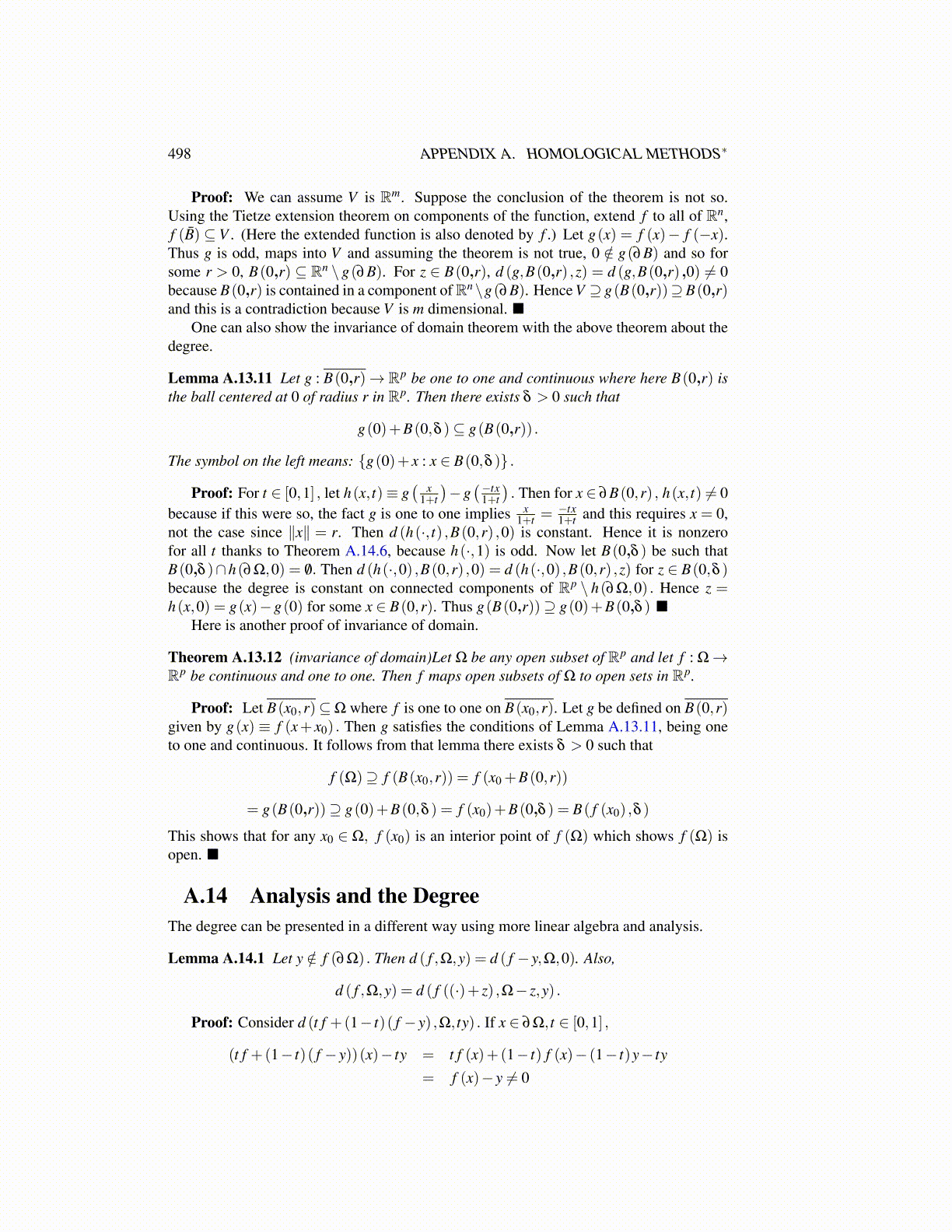
498 APPENDIX A. HOMOLOGICAL METHODS∗
Proof: We can assume V is Rm. Suppose the conclusion of the theorem is not so.Using the Tietze extension theorem on components of the function, extend f to all of Rn,f (B̄) ⊆ V . (Here the extended function is also denoted by f .) Let g(x) = f (x)− f (−x).Thus g is odd, maps into V and assuming the theorem is not true, 0 /∈ g(∂B) and so forsome r > 0, B(0,r) ⊆ Rn \ g(∂B). For z ∈ B(0,r), d (g,B(0,r) ,z) = d (g,B(0,r) ,0) ̸= 0because B(0,r) is contained in a component ofRn\g(∂B). Hence V ⊇ g(B(0,r))⊇B(0,r)and this is a contradiction because V is m dimensional. ■
One can also show the invariance of domain theorem with the above theorem about thedegree.
Lemma A.13.11 Let g : B(0,r)→ Rp be one to one and continuous where here B(0,r) isthe ball centered at 0 of radius r in Rp. Then there exists δ > 0 such that
g(0)+B(0,δ )⊆ g(B(0,r)) .
The symbol on the left means: {g(0)+ x : x ∈ B(0,δ )} .
Proof: For t ∈ [0,1] , let h(x, t)≡ g( x
1+t
)−g(−tx
1+t
). Then for x ∈ ∂B(0,r) , h(x, t) ̸= 0
because if this were so, the fact g is one to one implies x1+t =
−tx1+t and this requires x = 0,
not the case since ∥x∥ = r. Then d (h(·, t) ,B(0,r) ,0) is constant. Hence it is nonzerofor all t thanks to Theorem A.14.6, because h(·,1) is odd. Now let B(0,δ ) be such thatB(0,δ )∩h(∂Ω,0) = /0. Then d (h(·,0) ,B(0,r) ,0) = d (h(·,0) ,B(0,r) ,z) for z ∈ B(0,δ )because the degree is constant on connected components of Rp \ h(∂Ω,0) . Hence z =h(x,0) = g(x)−g(0) for some x ∈ B(0,r). Thus g(B(0,r))⊇ g(0)+B(0,δ ) ■
Here is another proof of invariance of domain.
Theorem A.13.12 (invariance of domain)Let Ω be any open subset of Rp and let f : Ω→Rp be continuous and one to one. Then f maps open subsets of Ω to open sets in Rp.
Proof: Let B(x0,r)⊆Ω where f is one to one on B(x0,r). Let g be defined on B(0,r)given by g(x) ≡ f (x+ x0) . Then g satisfies the conditions of Lemma A.13.11, being oneto one and continuous. It follows from that lemma there exists δ > 0 such that
f (Ω)⊇ f (B(x0,r)) = f (x0 +B(0,r))
= g(B(0,r))⊇ g(0)+B(0,δ ) = f (x0)+B(0,δ ) = B( f (x0) ,δ )
This shows that for any x0 ∈ Ω, f (x0) is an interior point of f (Ω) which shows f (Ω) isopen. ■
A.14 Analysis and the DegreeThe degree can be presented in a different way using more linear algebra and analysis.
Lemma A.14.1 Let y /∈ f (∂Ω) . Then d ( f ,Ω,y) = d ( f − y,Ω,0). Also,
d ( f ,Ω,y) = d ( f ((·)+ z) ,Ω− z,y) .
Proof: Consider d (t f +(1− t)( f − y) ,Ω, ty) . If x ∈ ∂Ω, t ∈ [0,1] ,
(t f +(1− t)( f − y))(x)− ty = t f (x)+(1− t) f (x)− (1− t)y− ty
= f (x)− y ̸= 0